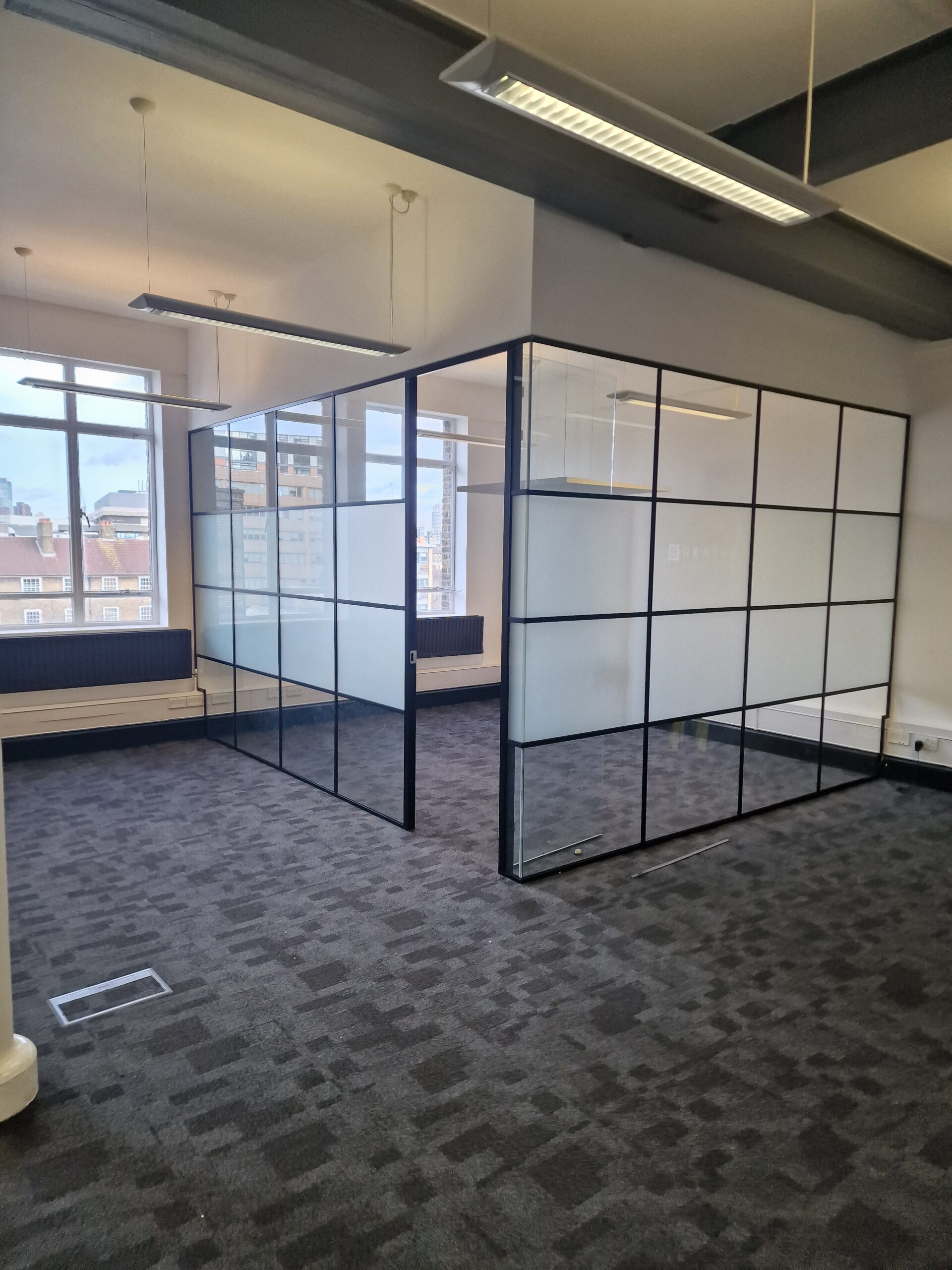
Satin etched glass and frosted glass are two popular choices in modern workspaces. Choosing the right glass can make a workspace feel open, calm, and sophisticated, while the wrong one can dull the atmosphere or limit natural light. That’s why many designers and business owners find themselves comparing satin etched glass to frosted glass. Both are stylish, privacy-friendly options, but each creates a very different visual and sensory experience.
This guide explores the real difference between satin etched and frosted glass, explains how manufacturers make them, examines their privacy and maintenance performance, and shows where each works best in commercial interiors. By the end, you’ll know exactly which type of glass aligns with your design goals and brand aesthetics.
What Is Satin Etched Glass?
Satin etched glass is a type of decorative glass created through a controlled acid-etching process that gives the surface a smooth, silky texture. It etched glass has a fine, uniform finish that diffuses light softly while maintaining excellent clarity.
During production, standard float glass is treated with acid on one or both sides. This precise chemical process removes a thin layer from the surface, creating a permanent satin-like appearance that won’t peel, wear off, or fade over time. It becomes a glass that feels luxurious to the touch and delivers a consistent matte look ideal for offices, partitions, and hospitality spaces where understated elegance is key.
What Is Frosted Glass?
Frosted glass is created by sandblasting, acid etching, or applying an adhesive film to the surface of clear glass, giving it a translucent, matte appearance. This finish scatters light while maintaining privacy, making it a popular choice for offices, meeting rooms, and commercial interiors that need both discretion and brightness.
Read More: What is Frosted Glass
Satin Etched vs. Frosted Glass – Key Differences
| Feature | Satin Etched Glass | Frosted Glass |
| Surface Finish | Smooth, satin-like texture | Textured, matte surface |
| Manufacturing Process | Acid-etched for a uniform satin sheen | Sandblasted or acid-etched for an opaque look |
| Privacy Level | Moderate to high (customisable) | High (consistent opacity) |
| Light Transmission | Soft, even light diffusion | Slightly more muted light diffusion |
| Maintenance | Easy to clean, resists fingerprints | Slightly rougher, can trap dust and smudges |
Which Glass Offers Better Privacy and Light Control?
When choosing between satin etched glass and frosted glass, the balance between privacy and light often determines the best option. While both obscure visibility, each achieves this effect in a distinct way.
Satin etched glass gently blurs outlines while maintaining a bright, open feel. The soft diffusion of light keeps spaces naturally illuminated, supporting focus and comfort.
Frosted glass, on the other hand, provides stronger visual privacy. Its denser, matte surface completely obscures shapes and movement. However, because it diffuses light more heavily, it can slightly reduce brightness compared to satin etched glass.
Design & Aesthetic Differences
Satin etched and frosted glass may both provide privacy, but their visual impact on a space is quite different.
Satin etched glass has a smooth, velvety surface that gives interiors a refined, high-end appearance. Its subtle sheen catches light beautifully, creating a soft glow that feels warm and contemporary. This makes it a favourite in offices, hospitality spaces, and showrooms where designers want to achieve understated sophistication without sacrificing functionality.
Frosted glass, in contrast, delivers a more defined, matte finish. It offers a clean, minimalist look that pairs well with modern interiors. Because of its stronger opacity, it can also serve as a bold visual divider, ideal for creating contrast between open and enclosed areas.
Businesses can customise both finishes with patterns, gradients, or company branding to align their choice of glass with their identity and interior design goals.
Durability and Maintenance
Both satin etched and frosted glass deliver long-term performance, but their surface textures affect how you maintain them.
Satin etched glass has a smoother, satin-like finish that resists fingerprints and smudges. Its uniformly etched surface allows you to clean it easily with a soft cloth and mild glass cleaner.
Frosted glass, on the other hand, tends to have a slightly rougher texture, especially when created through sandblasting. This means dust and oil can settle more easily on the surface, requiring more frequent but gentle cleaning.
For both options, tempering or lamination can be added for extra strength and safety, ensuring the glass remains durable under daily use while meeting commercial building standards.
Applications in Commercial Interiors
Satin Etched Glass Applications
Satin etched glass is often used where subtlety and sophistication are key. Its soft sheen and smooth texture make it perfect for office partitions, glass doors, reception areas, and feature walls.
Architects and designers also use satin etched glass for branding panels or interior accents, as its refined surface enhances lighting design and complements minimalist or contemporary interiors.
Frosted Glass Applications
Frosted glass, with its more opaque and textured surface, offering a higher level of privacy. It provides excellent light control while blocking clear visibility, helping to define boundaries in open layouts without making spaces feel enclosed.
In branded environments, frosted glass can seamlessly feature etched logos, gradients, or decorative patterns, thereby transforming functional partitions into striking visual elements that consistently reinforce brand identity.
Cost Considerations – Which Option Fits Your Budget?
When it comes to cost, satin etched and frosted glass are both affordable options for commercial interiors, though pricing can vary depending on finish, design complexity, and installation needs. Satin etched glass tends to be slightly more premium due to its refined, uniform finish and smooth surface, making it ideal for spaces where aesthetics is key.
Frosted glass, by contrast, can be a more budget-conscious option, especially when produced through sandblasting or film application. It provides reliable privacy and an elegant, professional look without stretching your budget.
Beyond the glass itself, factors like panel size, edge finishing, thickness, and custom branding will also influence overall cost.
Final Thoughts
Choosing between satin etched glass and frosted glass comes down to how you want your space to look and feel. Satin etched glass offers a smoother, more refined surface that enhances brightness and adds a touch of sophistication. Frosted glass, on the other hand, provides stronger privacy and a more traditional diffused appearance that suits a wide range of commercial interiors.
Both options perform exceptionally well in balancing light control and discretion, making them popular choices for modern offices and hospitality environments. The right selection depends on your design intent, whether you want a subtle glow or complete visual separation without compromising elegance.
FAQs
Yes, but it performs best indoors where surface exposure to pollutants and rain is minimal.
No. High-quality etched finishes remain stable and resist UV-related discolouration.
Absolutely. Frosted tempered glass is common in offices and commercial fit-outs for added safety.
Both have similar acoustic properties; thickness and lamination affect sound insulation more than surface finish.
Yes, both can be combined with tinted or laminated glass for added aesthetic or solar control benefits.
Satin etched glass tends to conceal smudges better due to its smoother, satin-like surface.
Yes, hybrid designs are increasingly popular, using frosted for privacy zones and satin etched for visual flow.













